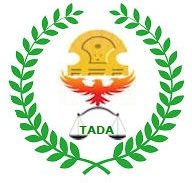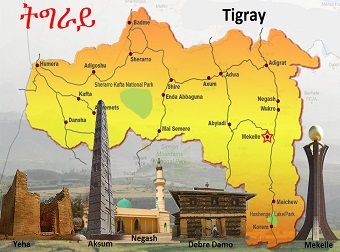In Tigray, where the Ethiopian government has imposed a complete communications black-out for over a year, journalists and aid organisations have suggested that this is also a de-facto aid blockade, as aid organisations have faced extreme difficulties in being able to operate, deliver aid or conduct any form of assessment of humanitarian need (Al-Jazeera, 2022). Humanitarian action has been severely hampered by a lack telecommunication services as well as fuel, banking services, and electricity (Mulford 2021). Ethiopia’s flagship social protection programme (PSNP) could be stopped in Tigray early in the conflict, as it was centrally managed by the federal government in Addis Ababa and it was dependent on mobile money or banks (WPF, 2021, GSMA, 2021a, GSMA, 2021b). Digital humanitarian cash transfers were already limited (GSMA, 2021a).
In Tigray, the only mobile phone and internet provider is Ethiotel, controlled by government, meaning it can easily be shut down
In Tigray, geopoll was able to conduct a phone survey in December 2020 but has not posted one since. While the data from Tigray was useful in providing information on displacement and market closures, the numbers reached were limited (46) (Elliott, 2020). At the same time in a face-to-face surveAs the WFP report on Tigray states: ‘…household-level quantitative surveys [are]… not suited to provide in-depth explanations of complex issues. Thus, questions on ‘how’ or ‘why’ are best suited to be explored through qualitative research methods’ (WFP 2022a: 12). Qualitative methods need proximity, or an on-the ground presence, and if done remotely need in-depth contextual knowledge and a relationship of trust with those being interviewed. This has implications for analysing causality, in particular understanding the structural causes of food insecurity (and malnutrition), how the crisis is presented, and for humanitarian responsey in Tigray in late 2021, WFP was not able to access western and southern parts.
Digital forensics and remote interviews with human rights organisations or monitors and investigators on the ground have played a key role in putting together evidence for starvation crimes in Yemen and Tigray. Remote technologies used by Global Rights Compliance and their partners include: Satellite imagery, Open-Source Intelligence (OSINT) on food price fluctuation; NASA’s Fire Information for Resource Management System (FIRMS) to identify increases in fire points which may indicate scorched earth tactics; Social-media Intelligence (SOCMINT) to uncover telegram and YouTube channels containing visual, audio or documentary footage. Satellite imagery can be used to monitor the destruction of houses, farms, markets, monitor market activity, populations movements. It has been used to help provide additional information in building a case on starvation, with imagery of scorched earth tactics, for example in Tigray (WPF 2021) or Darfur (Radio Dabanga 2020); or aerial bombardment campaigns in Yemen to identify whether agricultural areas have been deliberately targeted and destroyed and food producing facilities functional (GRC and Mwatana for Human Rights 2021). Satellite images have also been used to map displacement or estimate the number of people affected, for example in Myanmar (see for example: Human Rights Council, 2018). More closely related to food security, satellite monitoring of market activity in Tigray has recently been set up (Von Carnapp, 2022). Open street map (GIS), and crisis mapping using social media, are other examples (Twitter, SMS) (Thomas and Obrecht, 2016). ‘Ushahidi’ used these tools in the Haiti earthquake and later in Libya to map information on public health, security concerns and infrastructure damage.
Arguably a bigger issue, from the perspective of rights, famine risk, and starvation, is who has access to the digital beneficiary data, and whether civilian data are objects to be protected under IHL. Interviewees working on digital risk pointed out that centrally held information on digital identities can be politically controlled, and lead to politically motivated exclusions or even persecution. Benefits, bank cards, or humanitarian assistance, to certain population groups could simply be turned off (and which happened in Tigray). With such centralised digital data, particularly in situations of conflict, it is necessary to ask how the technology can be weaponised, and how new authorities will be using the digital identities created earlier.
Read the full article Digital-Feast-and-Famine
Quoted article
- Dannenbaum, T. (2021) ‘Famine in Tigray, Humanitarian Access, and the War Crime of Starvation’, available at https://www. justsecurity.org/77590/famine-in-tigray-humanitarian-access-and-the-war-crime-of-starvation/, accessed 28 March 2022.
- Elliott, R. (2020) ‘Remote Data Collection in Northern Ethiopia: Tigray and Amhara’, available at https://www.geopoll.com/ blog/remote-data-collection-in-northern-ethiopia-tigray-and-amhara/, accessed 24 March 2022
- https://www.tghat.com/2022/02/24/impact-of-the-internet-shutdown-in-tigray/
- WFP (2022a) Emergency Food Security Assessment Tigray Region, Ethiopia, Addis Ababa: World Food Programme.
- WPF (2021) Starving Tigray: How Armed Conflict and Mass Atrocities Have Destroyed an Ethiopian Region’s Economy and Food System and Are Threatening Famine, Boston: World Peace Foundation.

